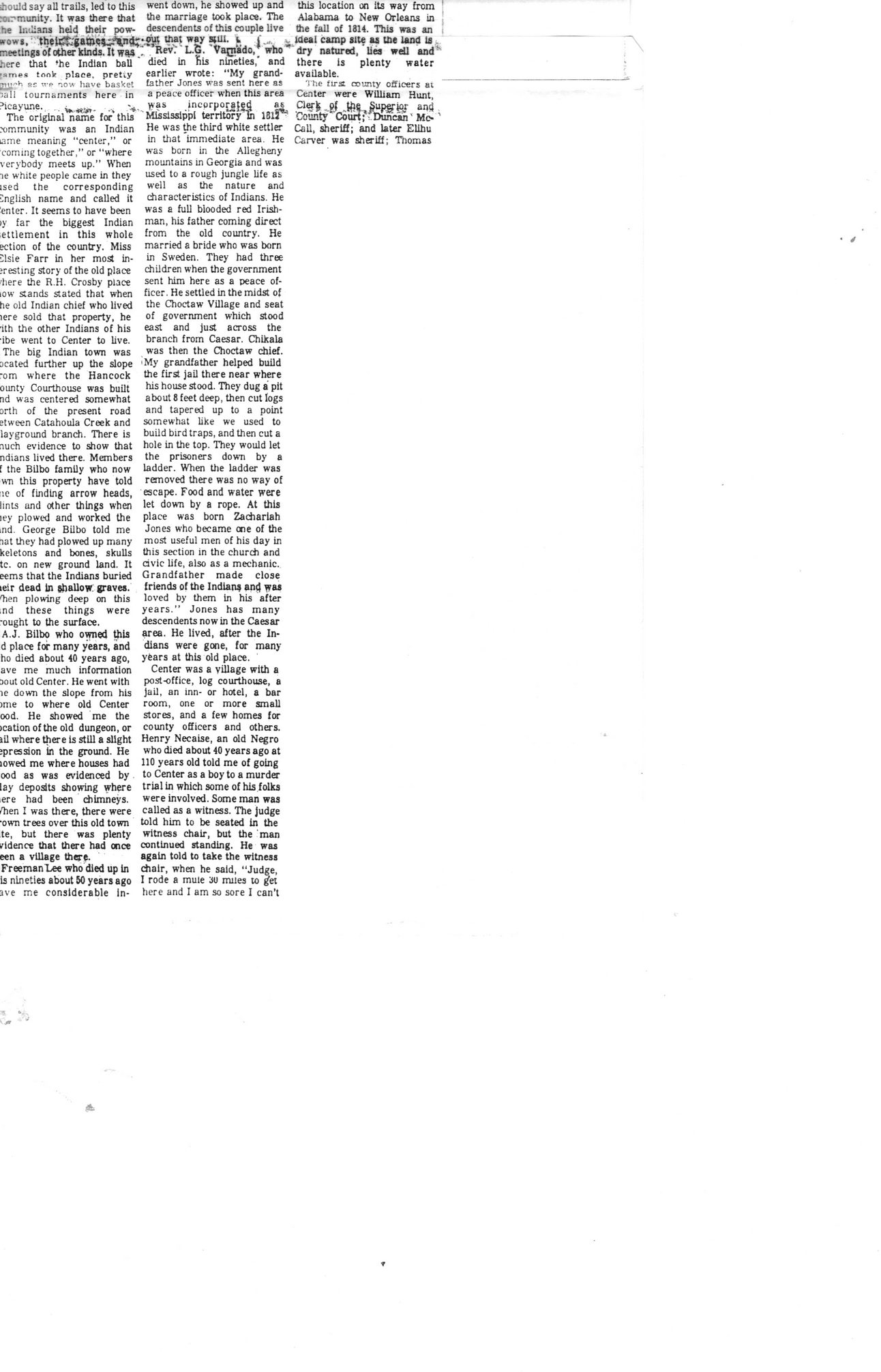This text was obtained via automated optical character recognition.
It has not been edited and may therefore contain several errors.
should say all trails, led to this went down, he showed up and this location on its way from roirmunity. It was there that the marriage took place. The Alabama to New Orleans in he Indians held their pow- descendents of this couple live the fall of 1814. This was an »ow», J- caxnp site u the Und la meetings of other kinds. It was Rev. L.G. Va£Tiado,; who dry natured, lies well and here that *he Indian ball ' died in his nineties, and there Is plenty water >ames took place, pretty °s vp now have basket :)all tournaments here in Picayune. .. ... v The original name for this ?ommunity was an Indian iame meaning “center," or coming together," or “where verybody meets up.” When ie white people came in they ised the corresponding English name and called it 'enter. It seems to have been >y far the biggest Indian ettlement in this whole ection of the country. Miss £lsie Farr in her most investing story of the old place 'here the R.H. Crosby place iow stands stated that when he old Indian chief who lived iere sold that property, he ith the other Indians of his ibe went to Center to live. The big Indian town was seated further up the slope •om where the Hancock ounty Courthouse was built nd was centered somewhat orth of the present road stween Catahoula Creek and layground branch. There is nuch evidence to show that ndians lived there. Members E the Bilbo family who now wn this property have told lie of finding arrow heads, lints und other things when ley plowed and worked the md. George Bilbo told me nat they had plowed up many keletons and bones, skulls tc. on new ground land. It eems that the Indians buried teir dead in shallow graves, 'ben plowing deep on this ;nd these things were ■ought to the surface. A.J. Bilbo who owned this d place for many years, and ho died about 40 years ago, ave me much information aout old Center. He went with le down the slope from his )me to where old Center ood. He showed me the (cation of the old dungeon, or ■til where there is still a slight ;pression in the ground. He lowed me where houses had ood as was evidenced by lay deposits showing where ere had been chimneys. (Tien I was there, there were ■own trees over this old town te, but there was plenty ddence that there had once een a village there. FreemanLee who died up in Is nineties about 50 years ago ave me considerable In- earlier wrote: “My grandfather Jones was sent here as a peace officer when this area Vas .incorporifsd « 'Mississippi territory in 1313 He was the third white settler in that'immediate area. He was born in the Allegheny mountains in Georgia and was used to a rough jungle life as well as the nature and characteristics of Indians. He was a full blooded red Irishman, his father coming direct from the old country. He married a bride who was born in Sweden. They had three children when the government sent him here as a peace officer. He settled in the midst of the Choctaw Village and seat of government which stood east and just across the branch from Caesar. Chikala was then the Choctaw chief. iMy grandfather helped build the first jail there near where his house stood. They dug a pit about 8 feet deep, then cut logs and tapered up to a point somewhat like we used to build bird traps, and then cut a hole in the top. They would let the prisoners down by a ladder. When the ladder was removed there was no way of escape. Food and water were let down by a rope. At this place was born Zachariah Jones who became one of the most useful men of his day in this section in the church and civic life, also as a mechanic. Grandfather made close friends of the Indian* and was loved by them in his after years.'* Jones has many descendents now in the Caesar area. He lived, after the Indians were gone, for many yfears at this old place. Center was a village with a post-office, log courthouse, a jail, an inn- or hotel, a bar room, one or more small stores, and a few homes for county officers and others. Henry Necaise, an old Negro who died about 40 years ago at 110 years old told me of going to Center as a boy to a murder trial in which some of his folks were involved. Some man was called as a witness. The Judge told him to be seated in the witness chair, but the man continued standing. He was again told to take the witness chair, when he said, “Judge, I rode a mule 30 miles to get here and I am so sore I can’t available. The first county officers at Center were William Hunt, aerfcI rn,§wipr and County Court; Duncan’McCall, sheriff; and later Elihu Carver was sheriff; Thomas

Kiln History Document (041)